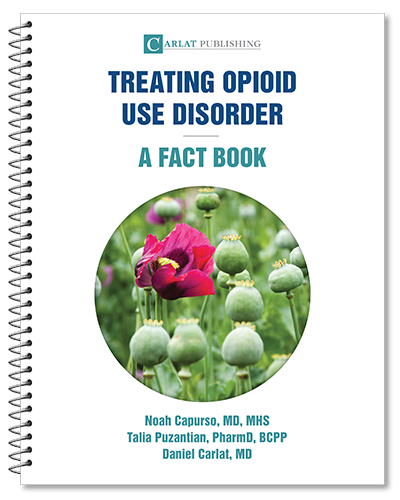Home » Updated Guidelines for Treating Opioid Use Disorder
Updated Guidelines for Treating Opioid Use Disorder
August 6, 2020
From The Carlat Addiction Treatment Report
Rehan Aziz, MD.
Associate Professor of Psychiatry and Neurology, Rutgers Robert Wood Johnson Medical School.
Dr. Aziz has disclosed that he has no relevant financial or other interests in any commercial companies pertaining to this educational activity
Before the COVID-19 pandemic, America was in the grip of an opioid crisis. Now, the medical community is sounding alarms that shelter-in-place orders may have triggered drug and alcohol relapses (Silva MJ et al, Am J Manag Care 2020;26(7):1–3). The American Medical Association has noted that at least 30 states have reported increases in opioid-related mortality over the last few months. Thus, social distancing, while critical, may be concealing another surge of unhealthy opioid use (www.ama-assn.org/system/files/2020-06/issue-brief-increases-in-opioid-related-overdose.pdf).
Against this backdrop, the American Society of Addiction Medicine (ASAM) released updated guidelines for the treatment of opioid use disorder (OUD). The guidelines were formulated by an independent expert committee convened by ASAM and were based upon the findings of a systematic literature review. Here, we comment on some major differences in the 2020 guidelines compared to the 2015 guidelines. For a quick summary, see the box at right.
Assessment
A recurring theme in the new guidelines is expanded use of medications for opioid use disorder (MOUD), with a focus on methadone and buprenorphine. To that end, the co-prescription of benzodiazepines and other sedative-hypnotics should no longer be a reason to withhold or suspend treatment with methadone or buprenorphine. Clinicians should also consider the risks associated with co-administration of central nervous system depressants. ASAM proposes that the harm caused by untreated OUD often outweighs these risks; this is in line with a 2017 FDA statement (www.fda.gov/media/107888/download).
In another change, ASAM recommends that a comprehensive assessment should not delay or prevent starting MOUD. This means MOUD could be started at a patient’s first appointment.
Medication treatment
All FDA-approved agents for the treatment of OUD should be made available to all patients. Methadone or buprenorphine are preferred. Oral naltrexone is no longer recommended because of high rates of non-adherence, although it may be useful for certain populations such as professionals in law enforcement or health care. By and large, if a naltrexone formulation is to be used, ASAM recommends extended-release injectable naltrexone. There is no suggested time limit or optimal duration of therapy for any MOUD.
A patient should be offered or referred to psychosocial treatment based on their individual needs. However, a patient’s decision to decline psychosocial treatment, or a lack of available options, should not stop or delay the initiation of MOUD. As such, during this pandemic, medications should be started even if other therapies are not accessible due to stay-at-home orders or clinic closings.
Starting buprenorphine
Buprenorphine can be dispensed in an opioid treatment program or prescribed by waivered clinicians in any setting, including the office. Previously, it was recommended that clinicians observe patients in their offices when starting buprenorphine. However, both office-based and home-based buprenorphine initiation are now considered safe and effective. Clinical judgment should be used to determine the most appropriate setting for starting treatment. The patient’s experience with buprenorphine and the clinician’s assessment of their ability to manage initiation at home should be part of that consideration.
Following initiation, buprenorphine should be titrated to lessen symptoms of withdrawal or cravings. To be effective, the buprenorphine dose should be enough to enable patients to discontinue illicit opioid use. Earlier guidelines had stated that buprenorphine doses after initiation should average 8 mg per day. The updated guidelines indicate that 16 mg per day or greater may be more effective than lower doses. There is limited evidence regarding doses higher than 24 mg per day. To reduce the chance of buprenorphine diversion, the guidelines recommend frequent office visits early on; drug testing for buprenorphine and metabolites; and appointments for medication counts.
Special populations: Individuals with pain
It’s been my experience that patients with OUD who develop acute pain are often undertreated with analgesic medications. This can occur due to a perception that patients are “drug-seeking” or that pain treatment with opioids may “worsen their addiction.” Unfortunately, untreated pain leads to patient suffering, mistrust in clinicians and health systems, and possible return to unhealthy or illicit use.
The ASAM guidelines now specify that an OUD diagnosis shouldn’t impede the use of additional opioids to treat pain. Some patients taking methadone or buprenorphine who develop acute pain will require extra opioid coverage. In this case, a short-acting full agonist, like oxycodone or hydrocodone, can be added to their regular medication. The dosage of the added opioid may need to be higher than the typical dose required for pain control in opioid-naïve individuals.
Another strategy for patients taking methadone or buprenorphine is to temporarily increase their dose or change their dosing frequency. The painkilling effects of methadone and buprenorphine last for about 6 to 8 hours, so splitting the daily dose into 3 to 4 times per day may maximize the analgesic effect. For buprenorphine, in supervised settings like hospitals, some patients may benefit from additional as-needed doses of buprenorphine.
Special populations: Periprocedural care
For patients undergoing surgery who are on methadone or buprenorphine, managing postoperative pain can be challenging. Some clinicians perceive a need to discontinue methadone or buprenorphine prior to surgery to promote a “clean slate,” thinking that these medications may negatively interact with periprocedural pain control and increase the risk of adverse events or overdose.
The updated guidelines indicate that discontinuation of methadone or buprenorphine before surgery isn’t required. Additionally, intravenous opioids can be used perioperatively for pain control. If it’s decided that methadone or buprenorphine should be stopped before surgery, this can be done the day before or the day of surgery, based on the surgical and anesthesia team’s recommendations. Methadone or buprenorphine can be resumed postop when the need for intravenous analgesia has lessened. Pre-surgery doses of these medications can be restarted if they were held for less than 2 to 3 days (Crotty K et al, J Addict Med 2020;14(2):99–112).
CATR Verdict: We’ve addressed some of the major revisions to the updated guidelines for OUD here. Their overarching theme is to provide MOUD to patients with as few barriers to treatment as possible and then to keep them on it. For reference, the full ASAM guidelines can be accessed at www.tinyurl.com/yyvkuaos
Key Updates for the Guidelines for Treating Opioid Use Disorder
Addiction TreatmentAgainst this backdrop, the American Society of Addiction Medicine (ASAM) released updated guidelines for the treatment of opioid use disorder (OUD). The guidelines were formulated by an independent expert committee convened by ASAM and were based upon the findings of a systematic literature review. Here, we comment on some major differences in the 2020 guidelines compared to the 2015 guidelines. For a quick summary, see the box at right.
Assessment
A recurring theme in the new guidelines is expanded use of medications for opioid use disorder (MOUD), with a focus on methadone and buprenorphine. To that end, the co-prescription of benzodiazepines and other sedative-hypnotics should no longer be a reason to withhold or suspend treatment with methadone or buprenorphine. Clinicians should also consider the risks associated with co-administration of central nervous system depressants. ASAM proposes that the harm caused by untreated OUD often outweighs these risks; this is in line with a 2017 FDA statement (www.fda.gov/media/107888/download).
In another change, ASAM recommends that a comprehensive assessment should not delay or prevent starting MOUD. This means MOUD could be started at a patient’s first appointment.
Medication treatment
All FDA-approved agents for the treatment of OUD should be made available to all patients. Methadone or buprenorphine are preferred. Oral naltrexone is no longer recommended because of high rates of non-adherence, although it may be useful for certain populations such as professionals in law enforcement or health care. By and large, if a naltrexone formulation is to be used, ASAM recommends extended-release injectable naltrexone. There is no suggested time limit or optimal duration of therapy for any MOUD.
A patient should be offered or referred to psychosocial treatment based on their individual needs. However, a patient’s decision to decline psychosocial treatment, or a lack of available options, should not stop or delay the initiation of MOUD. As such, during this pandemic, medications should be started even if other therapies are not accessible due to stay-at-home orders or clinic closings.
Starting buprenorphine
Buprenorphine can be dispensed in an opioid treatment program or prescribed by waivered clinicians in any setting, including the office. Previously, it was recommended that clinicians observe patients in their offices when starting buprenorphine. However, both office-based and home-based buprenorphine initiation are now considered safe and effective. Clinical judgment should be used to determine the most appropriate setting for starting treatment. The patient’s experience with buprenorphine and the clinician’s assessment of their ability to manage initiation at home should be part of that consideration.
Following initiation, buprenorphine should be titrated to lessen symptoms of withdrawal or cravings. To be effective, the buprenorphine dose should be enough to enable patients to discontinue illicit opioid use. Earlier guidelines had stated that buprenorphine doses after initiation should average 8 mg per day. The updated guidelines indicate that 16 mg per day or greater may be more effective than lower doses. There is limited evidence regarding doses higher than 24 mg per day. To reduce the chance of buprenorphine diversion, the guidelines recommend frequent office visits early on; drug testing for buprenorphine and metabolites; and appointments for medication counts.
Special populations: Individuals with pain
It’s been my experience that patients with OUD who develop acute pain are often undertreated with analgesic medications. This can occur due to a perception that patients are “drug-seeking” or that pain treatment with opioids may “worsen their addiction.” Unfortunately, untreated pain leads to patient suffering, mistrust in clinicians and health systems, and possible return to unhealthy or illicit use.
The ASAM guidelines now specify that an OUD diagnosis shouldn’t impede the use of additional opioids to treat pain. Some patients taking methadone or buprenorphine who develop acute pain will require extra opioid coverage. In this case, a short-acting full agonist, like oxycodone or hydrocodone, can be added to their regular medication. The dosage of the added opioid may need to be higher than the typical dose required for pain control in opioid-naïve individuals.
Another strategy for patients taking methadone or buprenorphine is to temporarily increase their dose or change their dosing frequency. The painkilling effects of methadone and buprenorphine last for about 6 to 8 hours, so splitting the daily dose into 3 to 4 times per day may maximize the analgesic effect. For buprenorphine, in supervised settings like hospitals, some patients may benefit from additional as-needed doses of buprenorphine.
Special populations: Periprocedural care
For patients undergoing surgery who are on methadone or buprenorphine, managing postoperative pain can be challenging. Some clinicians perceive a need to discontinue methadone or buprenorphine prior to surgery to promote a “clean slate,” thinking that these medications may negatively interact with periprocedural pain control and increase the risk of adverse events or overdose.
The updated guidelines indicate that discontinuation of methadone or buprenorphine before surgery isn’t required. Additionally, intravenous opioids can be used perioperatively for pain control. If it’s decided that methadone or buprenorphine should be stopped before surgery, this can be done the day before or the day of surgery, based on the surgical and anesthesia team’s recommendations. Methadone or buprenorphine can be resumed postop when the need for intravenous analgesia has lessened. Pre-surgery doses of these medications can be restarted if they were held for less than 2 to 3 days (Crotty K et al, J Addict Med 2020;14(2):99–112).
CATR Verdict: We’ve addressed some of the major revisions to the updated guidelines for OUD here. Their overarching theme is to provide MOUD to patients with as few barriers to treatment as possible and then to keep them on it. For reference, the full ASAM guidelines can be accessed at www.tinyurl.com/yyvkuaos
Key Updates for the Guidelines for Treating Opioid Use Disorder
- The use of benzodiazepines and other sedative-hypnotics isn’t a reason to withhold or stop treatment.
- An individual’s decision to decline psychosocial treatment shouldn’t stop or delay treatment with methadone or buprenorphine.
- Both office-based and home-based initiation of buprenorphine are considered safe and effective.
- For patients on methadone or buprenorphine with acute pain, short courses of short-acting full-agonist opioids are reasonable.
- Discontinuation of methadone or buprenorphine before surgery isn’t required.
KEYWORDS addiction-treatment buprenorphine medication methadone opioid-epidemic opioid-use-disorder pain pharmacology
Issue Date: August 6, 2020
Table Of Contents
Recommended
Newsletters
Please see our Terms and Conditions, Privacy Policy, Subscription Agreement, Use of Cookies, and Hardware/Software Requirements to view our website.
© 2025 Carlat Publishing, LLC and Affiliates, All Rights Reserved.


_-The-Breakthrough-Antipsychotic-That-Could-Change-Everything.jpg?1729528747)



